Do-it-yourself installation of a washing machine can be done by almost any man who has the most common set of wrenches, a head on his shoulders and “straight” hands. If you do not have these components, then connecting a washing machine with your own hands will be difficult for you, but possible. After all, this process is not particularly complicated and the main thing in it is to follow the clear instructions that we will provide you with.
Choosing a place for a washing machine
The first thing to do before installing a washing machine, and even before buying one, is to choose a place if you have not yet decided where to put your new washer. If it is, for example, a kitchen, then perhaps you will opt for built-in washing machine. Let's look at the options.
Installing a washing machine in the bathroom - The bathroom is probably the most optimal place to install a washing machine. Although, usually the bathrooms in our apartments are small in size, but there is a place for a typewriter in them. The machine can be placed there both next to the rest of the equipment, and built under the sink, although in this case you need to correctly choose the height of the washing machine.
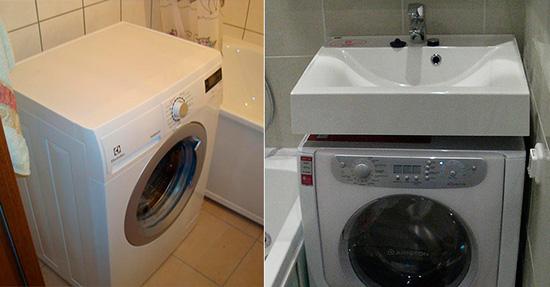
Installation and connection of the washing machine in the kitchen - many owners choose a place for a washing machine in the kitchen.It can be placed both under the countertop of the kitchen set, and next to it.
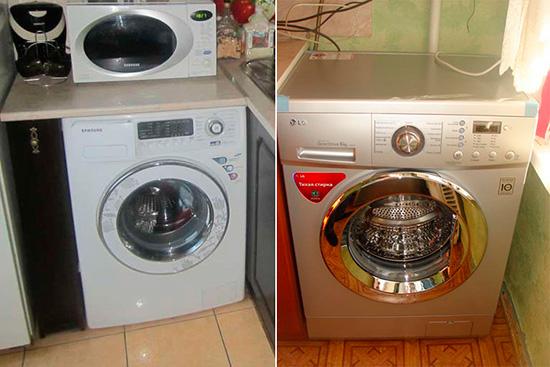
The kitchen is a great place if the bathroom does not have a large area, and the kitchen has better ventilation.
Installation of a washing machine in the hallway - oddly enough, but some families use a place in the hallway or pantry to install the machine. This is due to the fact that there is enough space in these places for a washing machine, and it is less valuable than space in the kitchen or bathroom.
It does not matter where you have chosen a place for the washing machine, the main thing is that it meets the following requirements:
- Communications must be close - plumbing and sewerage should be as close as possible to the installation site of the washing machine, otherwise you will have to lay them in this place. This also applies to the electrical outlet.
- The floor must be level and stable. - the machine should stand flat on the floor, it should not bend under its weight. The ideal option would be a concrete floor or tile.
Preparing the washing machine for installation
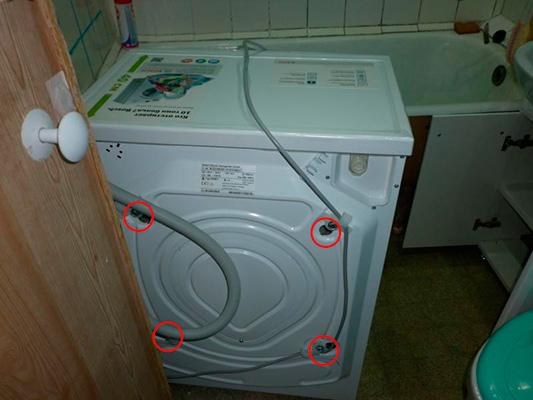
Before proceeding directly to the installation and connection of the washing machine with your own hands, you must first perform a series of actions:
- First of all, you need to read the instructions for the washing machine, because it describes all the requirements for connection and installation.
- Next, you need to unpack the washing machine and remove all the film from it. Of course, this is already understandable, you will say, and you will be right, but we cannot but recall this.
- The second step is to remove the shipping bolts. About, how to unscrew the transport bolts in the washing machine we have already described in detail on our website, so we strongly recommend that you study this information before reading further.
- After the bolts are removed, the holes from them must be plugged with special plastic plugs that come with the unit.
- Move the machine to its place of installation. No need to try to put the washing machine close to the wall, because we will still need access to the back wall.
Connecting the washing machine to the sewer
The first thing to do is connect the washing machine to the sewer. For this it is best install a siphon for a washing machine and connect through it. If this is not possible for technical or other reasons, then you can use a simple method: hang a drain hose on the bath, and all the water will drain into it.
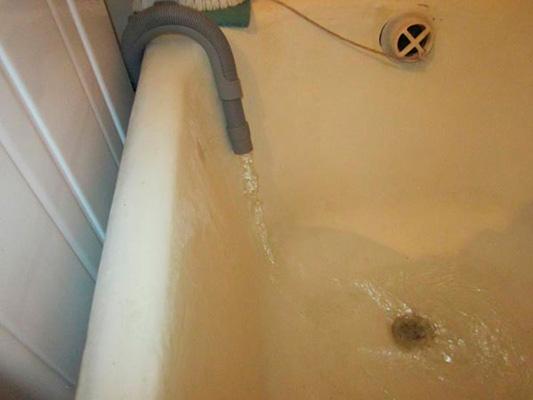
This method is not very good both from a practical and an aesthetic point of view.
No matter how you connect the washing machine to the sewer, you definitely need to read the instructions for it and see if there are requirements for the height of the bend in the drain hose. In machines with check valve such requirements may or may not exist. In the rest, the drain hose must be connected to a height of at least 50 cm from the floor.
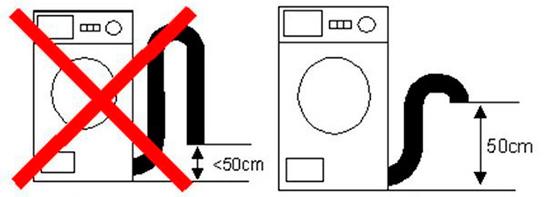
To connect the hose itself to the siphon, put the hose on the siphon and fix it with a clamp.
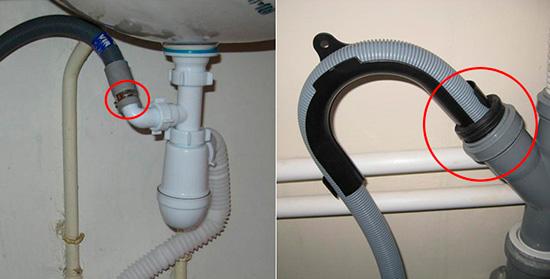
If you connect the hose directly to the sewer pipe, then you need to use a special rubber cuff. It is inserted into the pipe, and the drain hose from the washing machine is already stuck into it.
Connecting the washing machine to the water supply
In order for the washing machine to take water, you need to connect it to the water supply. To do this, you will need an inlet hose for washing machines. It can come as a set with a washing machine, or be purchased separately.
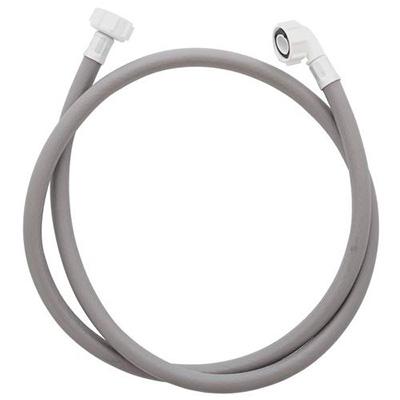
You screw one end of the hose (the one that is bent) to the washing machine. The second end must be connected to the plumbing. For this, a special branch with a faucet for a washing machine is usually made in the pipe. Or make a separate outlet for the machine. In the image you will see the simplest and most classic option for connecting the inlet hose of the washing machine to the water supply.
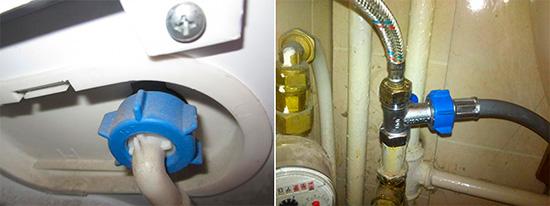
Before the flexible hose that goes to the cold water tap, a tee for the washing machine is screwed in and both hoses (for cold water and for the washing machine) are already screwed into it.
Some washing machines have two water inlets, one for hot and one for cold. In this case, you need to do the same with the hot supply.
Washing machine leveling
After we connected the washing machine to the sewer, we need to straighten it outto avoid vibration and noise. The legs of washing machines are adjustable, so if your floor is a little crooked, then you should not worry too much. In order for the washing machine to stand level, we need a level.
To begin with, we put the level along the washing machine and unscrew or vice versa screw the legs in order to change the slope in the direction we need.
After the machine is level, you need to shake it slightly by pressing on the corners, it should not swing or vibrate. If this happens, then adjust the legs without forgetting the level.

Next, you need to tighten the fixing nuts on the legs of the washing machine.
Connecting the washing machine to electricity
There is really nothing complicated here. The washing machine is enough to plug into the outlet, and it will work. But there are still some requirements for the power grid, let's look at them:
- Ideally washing machine must be grounded, i.e. your house must have a ground, and your outlet must have a corresponding third wire.
- But as a rule, grounding is not used in most Soviet houses, and in this case it is not possible to ground the machine. In this case you need to use an RCD with a cut-off current of 10mA for bathrooms and 30 mA for the apartment as a whole.
- Also, if the machine is installed in the bathroom, then it is necessary to use a special outlet protected from moisture.
After installation
After you have completed all the steps, you need to run first wash without clothesafter which the machine will be ready for operation.To more clearly demonstrate the installation process and correct connection of the washing machine to the sewerage and water supply with our own hands, we posted a video, which you can watch below.
